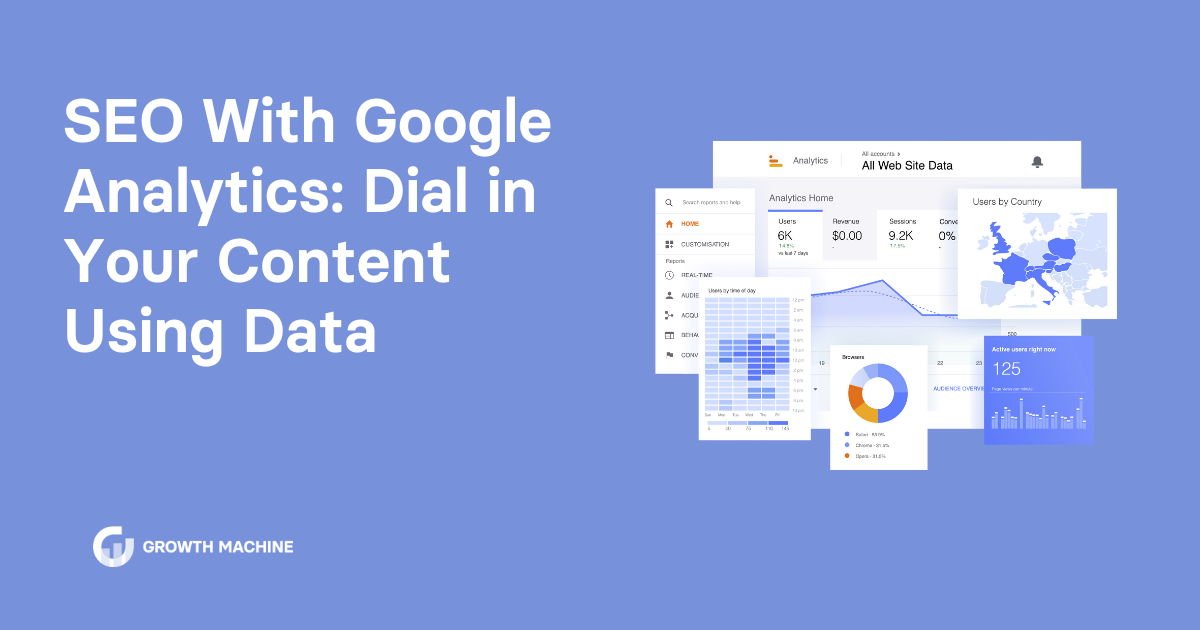SEO With Google Analytics: Dial in Your Content Using Data
If your goal is to optimize your website traffic this year, you need to have a solid grasp on 2 things: 1) How people are getting to your site; and 2) How they’re interacting once they get there.
Trying to create content without understanding this fundamental data is like painting blindfolded; you might create something beautiful, but chances are you’ll end up with a big mess and a lot of wasted resources.
When it comes to all-in-one website analytics, Google Analytics 4 (GA4 for short) is your best bet. Google Analytics provides valuable insights about your audiences’ behavior, painting a clear picture of how they’re interacting with your site. Learning how to utilize this tool can help you get the most out of your content, ensuring your SEO efforts don’t go to waste.
Let’s dive into how you can improve your SEO campaigns with Google Analytics and optimize your web pages to meet your business goals.
What Is Google Analytics/GA4?
Google Analytics is the most popular web analytics technology out there. And for good reason.
GA is an invaluable SEO tool for finding out where organic traffic is coming from, as well as how users are navigating your website. The most recent version of Google Analytics, GA4, was released by Google in 2020 with a new event-based data model that allowed digital marketers to better understand users and better predict behavior in an effort to improve user experience.
As a business or website owner, GA4 is your ultimate resource for making strategic decisions.
Content marketing isn’t cheap. When done well, it has a high payoff and can generate revenue for your business for years to come, but without the data to back it up, it’s nearly impossible to determine your content marketing ROI.
That’s where GA4 comes in. It can tell you whether a piece of content is driving users to your site, and whether those users are actually converting, as well as the average purchase revenue per user, both of which can shape your content strategy.
For example, if you actively post on your blog as part of your content marketing strategy, GA4 shows you which content is bringing in the most users, and who your most engaged users are. Understanding what kinds of content these users resonate with is your blueprint to creating similar high-conversion content and generating more revenue for your business.
How to Navigate GA4 for SEO
If you have experience with GA4’s predecessor, Universal Analytics (UA), you’ll find that the layout is somewhat familiar.
Similarly to UA, you can access analytics reports using the menu on the left side of the page, swap between different accounts and properties using the dropdown menu in the top-left, and configure your admin settings via the link on the bottom-left of the page.
Additionally, you can use the universal search box at the top of the page to ask Google specific questions about your data, such as how many visits a recent blog post received.
If you’re a complete newbie to Google Analytics, a good place to start is by setting up a Google Analytics account and taking the Home Page or Admin Tour, which will quickly run you through the different parts of the Google Analytics interface.
Tracking SEO Performance in GA4
If you’re just starting to explore SEO with Google Analytics, here are some reports you might find useful:
- Acquisition: This Google Analytics report provides a handy breakdown of how users are discovering your site, encompassing organic, direct, and paid search traffic. Within the report, you can compare different channels, such as your blog, Google Ads, social media accounts, and even external referrals through backlinks. You can use this report to assess content ROI by taking note of which channels are driving the most traffic and highest number of conversions.
- Engagement: Getting users to your site is only half the battle when it comes to SEO; it’s also important to keep them there. By digging into your engagement metrics, you can see where users might be dropping off, and troubleshoot in order to create a user experience that earns the favor of both humans and search engines.
- Audience demographics: Effective SEO is all about creating content that speaks to your audience’s interests. GA’s demographics report breaks down your audience by age, gender, language, location, and interests, so you can see exactly who your content is actually resonating with (and who it’s not).
- Explorations: While UA and GA4 have a lot in common, one thing that distinguishes GA4 is the new Explorations feature. There are many different exploration methods to choose from, from funnel exploration to better understand your user journey, to the user explorer which can help you better understand individual users’ activities. These explorations are a treasure trove of data, so don’t be afraid to jump in and get scientific with your understanding of your audiences’ behavior.
Integrating Google Analytics With Google Search Console
For a more holistic approach to SEO, we recommend integrating Google Analytics 4 with Google Search Console (GSC). This combination offers a more in-depth view of how users interact with your site, unlocking new avenues for search optimization.
GSC provides a more granular analysis on how your website appears in search results. It highlights specific queries that lead users to your site, the average ranking position of your web pages for specific queries, and the click-through rates (CTR) for each listing. This SEO data can then be used to identify high-performing keywords for you to target in future content pieces.
Linking your GSC with your GA4 interface can be done in the Admin section. By linking the two together, you’ll enable a more seamless flow of search performance data into your GA4 reports.
Once linked, revisit your Acquisition reports to find the “Google Search Console” section. If done correctly, you should now be able to view Google Analytics reports on search queries, landing page performance, and more. You can then cross-reference these behavioral metrics with GA4 for expert level analysis.
Measuring Key SEO Metrics in Google Analytics
In the era of GA4, business owners and marketers can develop a highly nuanced understanding of SEO performance.
Equipped with user-centric analytics data, you can optimize site performance and claw your way up the search engine results pages (SERPs). But in order to do that, you must understand exactly which data points will inform your SEO strategy.
Below is a list of important metrics that indicate the effectiveness of your website content.
Organic Traffic
Organic traffic is the first step to generating online visibility. Seeing your brand in the top results for a search query builds both brand recognition and trust, boosting your chances of converting website visitors to paying customers. You can view organic traffic data through the Acquisition report to uncover insights into how users are finding your site and what portion are coming from search engines. A steady increase in organic traffic over time is usually a good indicator of a healthy SEO strategy.
Engagement Rate/Bounce Rate
Compared with UA, GA4 presents a shift from more traditional bounce rates to metrics like engagement rate. Your website’s engagement rate is a more holistic measure of user interaction, as it factors in time spent on site, scroll depth (how far a user scrolls on a page), and content interactions. High bounce rates (or a low engagement rate) might signal that your content isn’t meeting audience expectations, and needs to be adjusted in some way.
Conversion Rates
GA4’s Conversions report allows you to measure how effective your site is in encouraging users to take action. Depending on the nature of your business, these actions might look like making a purchase or filling out a lead generation form. Tracking the real-time path your audience follows from organic search to conversion can help you pinpoint your ROI more effectively, and show you which areas are driving the most value for your business.
Site Speed and User Experience
While high-quality content is the cornerstone of effective SEO, it’s only one part of the equation. Site speed continues to be a make-or-break when it comes to SEO. You can assess your user experience using GA4’s Site Speed report, which offers a detailed breakdown of metrics like load time, interactivity, and stability of content as it loads. This data helps to identify pages that need to be optimized for faster load times, ultimately enhancing your user experience and SEO performance.
Practical Tips to Improve SEO With Google Analytics
Armed with a better understanding of how to use Google Analytics, the next step is to take that raw data and turn it into actionable steps to improve your website performance.
Here’s a step-by-step guide to make the most of SEO with Google Analytics:
- Set up conversion events: Once you’ve set up Google Analytics for your site, define specific user actions as conversion events in GA4. This can range from a form submission to a product purchase. By tracking the performance of your marketing campaigns in this way, you’ll be able to assess the effectiveness of your SEO strategy in achieving your business goals.
- Track engagement metrics: A high engagement rate is one of the best signs that your content is resonating with your target audience. Focus on improving user engagement metrics, such as session duration on specific pages, over a set period of time. These insights can help you optimize your content and site design to better meet your audience’s needs.
- Monitor acquisition reports: A regular review of your Acquisition reports is the key to understanding how your various marketing efforts are contributing to your traffic. Track how users from different channels behave, which search queries they’re using, and which channels are the highest converting, so you know where to focus your efforts.
- Optimize your site for page speed: Much like your vehicle needs an oil change every so often, it never hurts to revisit your Site Speed reports to see which pages might need a little TLC. If there are pages underperforming in terms of load time, make note of these for technical SEO improvements. With some small adjustments (like compressing images, removing unnecessary JavaScript, or limiting redirects), you can significantly enhance your user experience, reduce bounce rates, and boost your search rankings.
Make the Most of Your SEO With Google Analytics and Great Content
By utilizing data from GA4 and Google Search Console, you’re well on your way to taking your content marketing to the next level.
The right content partner can ensure that you’re at the top of your SEO game by creating content that your target audience can’t ignore. Just look how we helped this keto brand attract 100,000+ sessions in monthly traffic. It’s all thanks to an aggressive content plan that capitalized on spikes of interest identified through data analysis.
Contact Growth Machine today to improve your content ROI with analytics-backed content strategies and expert-crafted content.







